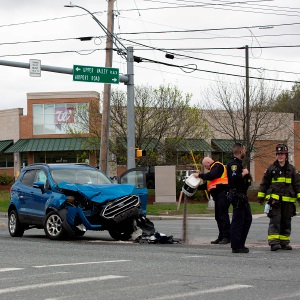Yes, Major Quakes Can Happen Here
| Published: 04-17-2016 12:38 AM |
Lebanon
It could happen in Charlevoix, Canada, as it did in 1663, and cause economic losses of $220 million.
It could even happen in a populated area like central New Hampshire, as it did in 1638, in which case it would injure thousands, kill about 100 people, leave 72,000 without power, and displace 4,500 people from their homes.
The truth is, though they have created projections — including the figures cited above — to help prepare the public in the Upper Valley and elsewhere, scientists don’t agree on when and where the region’s next massive earthquake will happen.
Earthquakes typically are associated with tectonic plates, the land masses that form the outer shell of the Earth and create fault lines where they collide. Scientists identified that process decades ago and it’s now used to explain about 98 percent of the world’s earthquakes.
But though there are no active fault lines in Vermont, New Hampshire or the surrounding environs in New England and Canada, the Earth still shakes here. In 1953, a magnitude-4.0 quake was centered in Brandon, Vt. Nine years later, on April 10, 1962, a Middlebury-based magnitude-4.1 tremor shook the area, weakening two beams under the Statehouse dome in Montpelier, where it also dislodged another support beam and cracked nearly two dozen windows.
Earthquakes are measured using the moment magnitude scale, which increases geometrically. That means small increases in magnitude represent large increases in ferocity. For example, a magnitude-5.0 quake has 10 times the motion, and 30 times the energy release, of a magnitude-4.0 quake.
For these quakes, and more recent ones, like a magnitude-2.9 seismic event based near Concord that rattled homes two weeks ago, the tectonic plate theory does not apply.
Article continues after...
Yesterday's Most Read Articles
 Homeless Upper Valley couple faces ‘a very tough situation’
Homeless Upper Valley couple faces ‘a very tough situation’
 Lebanon’s Jewell back from auto accident, more aware of ‘drowsy driving’ dangers
Lebanon’s Jewell back from auto accident, more aware of ‘drowsy driving’ dangers
 Plan on track to ship Upper Valley mail to Connecticut for sorting
Plan on track to ship Upper Valley mail to Connecticut for sorting
 West Lebanon crash
West Lebanon crash
 Crane crash on Interstate 89
Crane crash on Interstate 89
“We’re nowhere near a plate boundary here,” said Leslie Sonder, a professor of earth sciences at Dartmouth College who studies the movement of those plates and teaches students about natural disasters. “The closest plate boundary is in the middle of the Atlantic. That’s thousands of kilometers away.”
Sonder said scientists have theories, but no hard facts, about what causes New England quakes. One theory is that they’re signs of the Earth’s crust slowly rebounding after bring pressed down by the weight of glaciers. Another is that we’re in the early days of the development of a new plate boundary in the Atlantic, which would, over tens of millions of years, lead to a tectonic plate slipping underneath the entire East Coast, pushing the existing terrain up and creating a volcano-ridden, earthquake-prone zone similar to current-day Japan.
Both theories could be true, said Sonder.
Without knowing more about what causes New England earthquakes, they are, unlike their counterparts in most of the world, completely unpredictable.
“I think there was more optimism in the ’70s that we could get to the point that we could predict earthquakes,” Sonder said. As the decades passed, the optimism was not borne out, “but we’re continuing to work.”
Because of that fundamental lack of understanding of local earthquakes, and the resulting inability to predict them, no expert will say definitively that a large, catastrophic earthquake won’t happen here — this century, this decade, or even this week.
“We think it’s very unlikely,” said Sonder, “but that doesn’t mean that it can’t happen. It could.”
Utter Devastation
In order to measure the impact of a potential large-scale earthquake in the region, in 2012 the Federal Emergency Management Agency produced a study of 11 different earthquake scenarios, each one based on one of the large quakes that have already struck the area, including a 1983 earthquake in Goodnow, N.Y., and a 2002 quake in Plattsburgh, N.Y.
“The potential exists for large damaging earthquakes to strike again in the northeastern U.S. but with much more disastrous results because of the significant increase in population and the built environment since the beginning of the 20th century,” concluded the authors.
One of the scenarios looks at a repeat of the June 1638 earthquake in central New Hampshire. The magnitude-6.5 temblor shook the ground so violently that people were thrown off their feet and stone chimneys fell to pieces. The temblor was felt as far away as the Seacoast, where “the islands in the ocean were shaken violently, and the vessels that rode in the harbors and those sailing along the coast were acted upon as if a series of tidal waves had passed under them,” according to historical accounts of the day cited by the U.S. Geological Survey.
The study finds that, were the quake to happen today, $8.2 billion in damage would be spread over 57 counties in New Hampshire, Vermont, Maine, Massachusetts and Rhode Island, including structural damage to 6,400 residences, 1,600 commercial buildings, 218 hospitals, 115 schools, 39 police stations and 34 fire stations and 32 highway bridges. Damage to utilities, which would include $1.2 billion worth of damage to the power grid and damage to 81 gas pipelines and 468 water pipelines, would result in the loss of water to 3,000 households and power to 72,000 households.
There would also be a nightmarish aftermath.
“Fires often occur after an earthquake,” the study said. “Because of the number of fires and the lack of water to fight the fires, they can often burn out of control.” Some 1,250 people would be displaced by fires, the study estimated, and $89 million in property would be damaged. The quake would produce enough rubble to fill 67,200 dump trucks, and the economic impact would spin out for as many as 15 years, even accounting for an influx of aid.
The FEMA scenario assumed an earthquake epicenter near Concord, 50 miles away, meaning most of the death and destruction would be centered there, with counties in the Upper Valley suffering a small fraction of the costs.
If the epicenter were located at the heart of the Upper Valley — Lebanon, for example — the immediate area would, of course, be devastated.
House of Cards
If a large earthquake were to hit the Upper Valley hard enough to threaten buildings, bridges and roadways, some of those structures will fare better than others, according to structural engineers including Chris Temple, who works for Montpelier-based DeWolfe Engineering Associates.
Buildings are generally built to withstand the vertical pressure of gravity, but when a building shakes from side to side, that creates horizontal pressure, and not all buildings have been built with these stresses in mind.
Vermont’s Fire and Building Safety Code, which was most recently updated in 2012, protects only “essential buildings,” defined as hospitals; fire, rescue, and police stations; emergency vehicle garages; water storage and pumping structures; and emergency operation centers.
But all commercial buildings in Vermont are required to meet the 2012 International Building Code. New Hampshire uses the 2009 code, which does not have a significant difference when it comes to earthquake preparedness.
The impact of the International Building Code’s requirements can be seen in many buildings. The plywood sheathing on the outside walls of a store, the bracing propped up against the walls of a hockey arena, the ultra-stiff welded joints of a steel-framed bank, all are there to prevent horizontal pressure from leading to disaster.
But these protections haven’t always been in place — in fact, they’re fairly new. Building codes began to take earthquakes more seriously only after a 6.7 magnitude quake in Northridge, Calif., in 1994 injured more than 8,700 people.
Buildings that were built before 1994 are more likely to be susceptible to earthquake damage, said Temple. And those codes apply only to commercial buildings. When it comes to residences, homeowners are largely on their own.
“Most towns in Vermont and New Hampshire don’t have residential codes,” Temple said. “For residential, it’s mostly just zoning requirements. But there aren’t any structural performance requirements.”
The wood used to construct most homes has some give that allows the structure to sway with the ground, which is good. The least-safe homes, said Temple, include modern-looking contemporary houses with enormous windows built into walls made of masonry, which has little flexibility.
Worst of all are historic structures built of bricks, which have no give to them and, in some cases, need a relatively modest amount of horizontal pressure to collapse under their own weight, according to Tim Schaal, an engineering consultant with Schaal Engineering in White River Junction.
“If we look at buildings that were historically built and designed, there was very little consideration given” to earthquakes, he said.
Examples of these buildings are particularly prominent in areas such as the downtowns of Hanover, White River Junction, Lebanon and Woodstock, among others.
Some of these differences can be seen on the Dartmouth College campus, said Jack Wilson, an architect and teacher at the college who also has been involved with the building and renovation of many of the college’s buildings under the auspices of its planning and design office.
Wilson said he’s seen many earthquake-ready features installed on the campus since the mid-’90s, when the International Building Code was adopted.
The Boss Tennis Center and the Campion Rink are based on huge steel frames with stiff, movement-resistant joints. The Life Sciences Center has a braced frame and plywood sheathing that help its walls resist horizontal pressure. The Rauner Library in Webster Hall was built before any seismic codes were in place, but it has since been bolstered with braces and sheathing supports.
However, Wilson said, there are a lot of buildings on the campus that predate local adoption of the International Building Code.
“The tallest buildings on campus are probably Baker Tower and the Fairchild tower,” he said. “Baker Tower probably could be approved by zoning ordinances now. But Fairchild,” built in 1972, “couldn’t be because zoning doesn’t allow occupancy of a building over 65 feet tall.”
The tower, part of the Sherman Fairchild Physical Sciences Center, is described in a way that accentuates its susceptibility to an earthquake in the book Dartmouth College: An Architectural Tour. The book refers to it as “a massive center spine of Brutalist concrete, yet sheathed in glass; diaphanous for most of its height, but topped by a heavy, flat brow.”
Cost of Safety
When it comes to earthquake preparedness, there are costs, and there are costs.
One cost factor policymakers weigh is the prospect of a massive earthquake — very unlikely during the lifetime of any particular building. Another is the estimated cost of making every structure earthquake-safe.
In this sense, requiring only new buildings to adopt earthquake-preparedness features makes sense, said Schaal, because such features are relatively inexpensive when they’re part of the original design.
That’s not the case with older buildings — and the system makes allowances for that, even when one comes up for inspection because, for example, an old warehouse is being converted into storefronts and condos.
“Once you change use and put it where you’re going to put more people into it and make it a higher hazard use, it’s possible the codes may require the buildings to be upgraded to handle horizontal loads,” Schaal said.
But even in many of these cases, the measures are not taken.
“Our code officials are allowed to exercise judgment on whether a specific use requires them to be upgraded or not,” Schaal said. “The codes and officials are very forgiving to buildings that have historic value.”
One example of this trade-off came in 2009 in Claremont, where local officials celebrated when it turned out that a renovation to an existing portion of Stevens High School would not have to meet seismic requirements, which created a cost savings of $1.6 million on a $22.1 million project.
Response Critical
Should the worst happen — a large-scale earthquake affecting the Upper Valley — one institution almost certain to be taxed to the limits is Dartmouth-Hitchcock Medical Center.
In the hospital’s underground level, there’s an unassuming conference room that acts as the designated “war room,” the location where the center’s trained emergency team converges to direct the institution through a crisis.
If that room is unavailable — flooded, say, or without power — there is a backup room. If both rooms are unavailable, there’s a backup to the backup.
It’s the kind of redundancy Darlene Saler, associate chief nursing officer and overseer of emergency management operations, said could be necessary should a large-scale disaster like an earthquake shake the Upper Valley.
A large part of the emergency team’s efforts are geared toward building those redundancies.
The grounds hold five generators that stand ready to kick in and provide power to different parts of the hospital. If the internet is interrupted, there are backup systems that offer limited access to the systems most critical to patient care. If cellphones and landlines both go down, they’re prepared to use radios to keep the information flowing. The team includes former Lebanon police Chief Jim Alexander as the coordinator, and Eric Martin, a trauma surgeon and one of two medical directors on the team.
When a disaster happens, “you can sense the buzz, the adrenaline,” Martin said.
In all, dozens of people spend thousands of hours each year assessing threats and mustering the staff, equipment and protocols needed to meet them.
If an emergency were to overwhelm their capacity, they have an established communication protocol with other hospitals, and a transport plan in place to handle the overflow.
Once a year, the team pores over a list of disaster scenarios, such as floods and hurricanes, to decide which should receive the most resources in the coming 12 months. The winning scenarios are those most likely to happen, and most likely to cause a lot of damage when they do.
Based on that metric, epidemics and ice storms will receive most of the focus this year, while other events, like volcanoes and tidal waves, are judged to have no chance of occurring.
Of all the disasters on the list — floods and hurricanes, wildfires and blizzards — none is expected to damage more property, interrupt more services, or cause more deaths and injuries than an earthquake.
Nevertheless, earthquakes still get a low priority for specific training resources because one is considered unlikely to happen in the first place.
Still, said Rick Adams, the DHMC spokesman who is in charge of both internal and external communications during crises, the obstacles during an earthquake — worried and stressed staff members, a sudden large volume of injured people, possible loss of power and information systems within the building — would also be present in some of the other disasters that staff do specifically train for.
“We’ve got to be ready for these things,” Adams said. “We’ve got to be ready to answer the bell when it rings.”
Matt Hongoltz-Hetling can be reached at mhonghet@vnews.com or 603-727-3211.

 Kenyon: Constitutional rights should trump Dartmouth’s private interests
Kenyon: Constitutional rights should trump Dartmouth’s private interests
